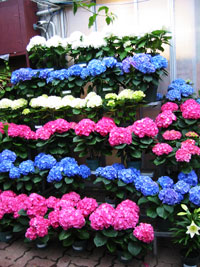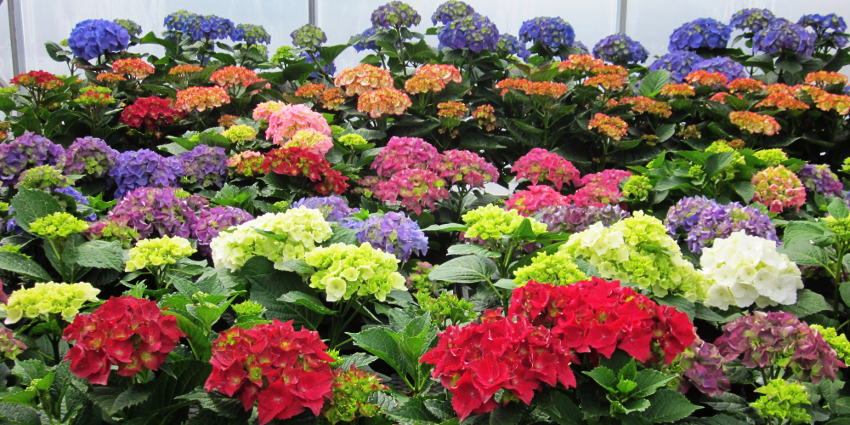Every year at Easter, there are two plants that go hand-in-hand with this holiday - Easter Lilies and Hydrangeas.
In our climate, we can't take all the advice from people in warmer climates when caring for hydrangeas so what do you do?

Hydrangeas aren't really indoor plants by nature and really do better outdoors in the long run. However, in the cold Ottawa winters, they really aren't ideally suited to being outdoors, either. So what options are we left with? The most common is to treat the plant as disposable and just enjoy the flowers while you can. It won't last forever, but it does add a nice and bright spring-time feeling to your home.
The big-leaf hydrangea or Hydrangea macrophylla is the one used for indoors near Easter. In warm climates the like sun to part-shade conditions. In the house, bright light is ideal, but since they are already flowering, nearly any light is good enough since you're only really trying to keep the flowers and not promote ideal growth. Since the big-leaf hydrangea only produces flowers on old-wood, the plant you see in your pot is at least a year old, and sometimes older. As such, they tend to have a very large root system and dry out very quickly. Hydrangeas should be checked for water very frequently, sometimes twice a day. In the greenhouse on a sunny day, we often need to water three times a day!
Once you get your watering schedule down-pat, there's one other trick with the big-leaf hydrangea. They're natures pH meter. The more acid the soil, the more blue the flowers are and the more alkaline, the more pink. Since most city water is close to neutral, the pinks are pretty reliable at staying pink. Blue hydrangeas, on the other hand, have a tendency to shift to a purple colour with regular waterings. In order to keep your blue hydrangea blue, you need some acid in the soil. Outdoors, there are many options, but indoors you're a little more limited. I like to add some lemon juice to the water. The citric acid helps keep the water a little more acid and there's no harm to you, your plants, or your pets. In fact, our water at the nursery is naturally so alkaline, we inject food-grade citric acid into the water to balance it out. Most plants have a hard time absorbing nutrients in an alkaline soil so a slightly acid soil is preferable for all plants (with a few exceptions of course).
So what if you want to keep your hydrangea all year? Can you just keep it as an indoor plant and have it flower again? As a woody plant, hydrangeas need a rest period. They need about 3-4 months of cold temperatures right around the freezing mark. Without this cold period, the plant will not flower and it can eventually die. This presents a very large roadblock for most home gardeners wishing to keep their hydrangeas indoors all year.
Quite a few people have planted hydrangeas outdoors with mixed success. The first thing to do is find the most sheltered spot in your garden. Plant the hydrangea out at the end of May when the risk of frost is over. Cut the plant back to about 4"-6" from the ground. This will stimulate shorter and denser branching making it easier to overwinter. When the winter comes, try and cover as much of the plant with mulch, leaves, or anything else that will protect the plant. Remember, hydrangeas flower off old growth so you can't cut off any branches and if any branches die-back from the cold, they won't flower either. It is very common that your hydrangea will comeback year after year, but without any flowers. Since the plant is root hardy but not bud hardy (the roots can take more cold than the branches, the plant shoots up new growth every year from the roots, but it can never flower on this new growth. That's what happens in my garden. At the nursery, there is one pink hydrangea that has successfully lived the winter and flowered so it is possible, but it's very protected.
All in all, hydrangeas are beautiful plants around Easter and it's worth having them around. Even if you can't keep them year after year, take the time to enjoy them in your house while they last. After all, you're not going to get a stronger burst of colour that early in the spring than you get from a large flowering hydrangea.

